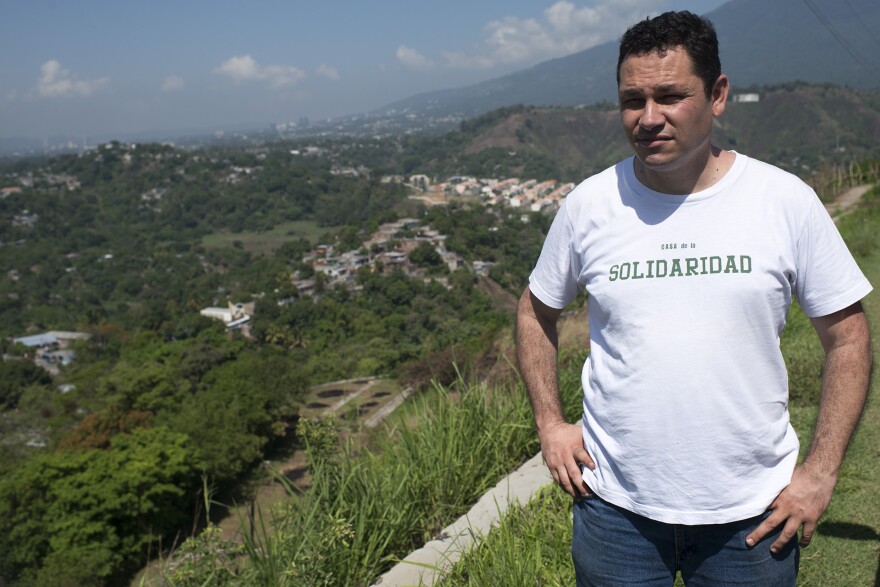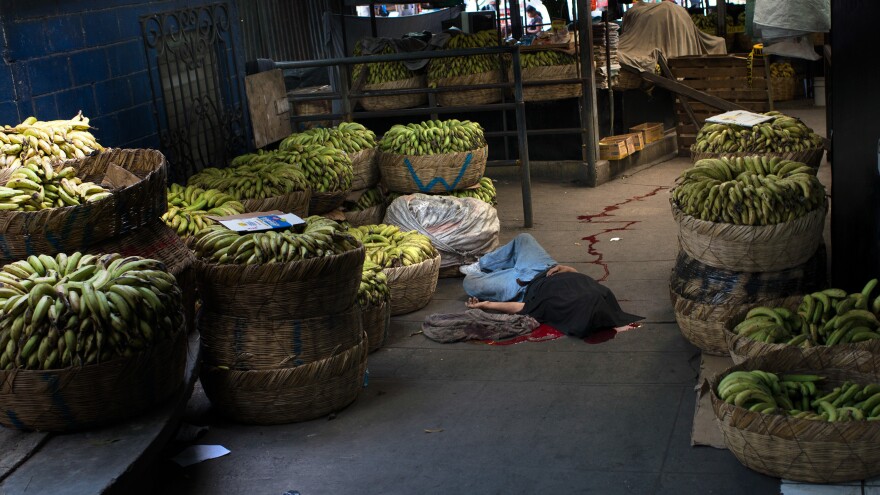Warning: Some of the depictions and images in this story are graphic.
Violence is rampant in El Salvador. In the month of August alone, there were 900 homicides. That's a daily average of 30 murders in a country with a population of 6.3 million — less than New York City.
At least 35 of those murders have been officially ruled feminicides — a crime involving the violent and deliberate killing of a woman.
The violence is seen largely as a product of two warring criminal gangs, MS-13 and the rival Barrio 18. There are very few spaces in the country that these gangs have not staked out.
The violence is often as senseless as it is massive. Just a day after arriving in the country, our reporting team found ourselves at a grisly scene: A 15-year-old girl had been shot at close range while crossing a busy intersection. Marcela's family told us they believed she'd been murdered for living in one gang's territory but selling tortillas in another. She'd crossed the wrong street.
The Rev. Gerardo Mendez, who has been a priest in San Salvador for nearly a decade, works closely with at-risk populations — youths living in areas firmly under a gang's grip. He sat down with us and answered some questions about the situation in El Salvador.

Where did these gangs originate?
In the U.S., in Latino neighborhoods, especially in Los Angeles. The city was divided into the Chinese neighborhood, the black neighborhood and then the Latinos. Among the Latino population, there were two notable groups: Mexicans and Salvadorans. Salvadorans became a presence in Los Angeles in the period between 1980 and 1992, which was the Salvadoran civil war.
Who was leaving El Salvador during the civil war?
Everyone. Entire families, young people, and both army and guerrilla deserters. And in Los Angeles, these Latino groups, like African-American groups, lived a difficult, marginalized life.
Above all, these gangs originated as self-defense groups, defending the Latino community, and the neighborhood, from other neighborhoods coming in to steal or inflict damage. There was originally a phrase that many of these gangs used, "Vivo por mi madre, muero por mi barrio" ("I live for my mother, I die for my neighborhood.") It's a promise to defend the community from abuses.
How did those LA gangs take root in El Salvador?
In the '90s, as the gang phenomenon in Los Angeles got more complicated, the U.S. started deporting gang members. Deportations brought airplanes full of gang members who had committed crimes and murders in the U.S. back to El Salvador.
When they got back to El Salvador, the civil war was over. What was the country like?
Not only was there no clarity about to what to do with these people — there was no infrastructure. The national police force was barely forming (it was born in 1992 with the peace agreements, and formed by ex-military and ex-guerrilla). These circumstances make it hard to pay attention to the gang problem.
The deportation of gang members back to El Salvador coincided with a very complicated social environment in the country, in which family life had been broken, financially and culturally.
Violence has always been present in this country. This is nothing new. The civil war is a violent past, but the extermination of indigenous people in 1932 is another example of how in El Salvador, violence erupts easily.
That is a reality that it seems we've inherited and it would seem that we can't ... that it's difficult for us to imagine El Salvador without violence. As if violence was part of its story, of its identity.
It shouldn't be that way.

You say these groups started off with a self-defense agenda. Why did they turn to criminal activity?
When these gang members arrived back to El Salvador, keep in mind the government had no re-integration policy. No psychological support. There's been a lack of serious policy toward these gang members' realities.
The absence of any type of government programs led to young people living in a state of abandon, and a predatory logic started gaining ground: Killing became easy — and so did extorting. Gangs start taking on a criminal nature, above all dealing in extortion.
Do any of these gangs have a political ideology?
It's hard to say. Not usually. What we usually see is that gangs defend whatever political party has their best interest in mind, or respects them. Or they side with whatever party does not repress them.
If neither group has a political ideology and they're all from the same country, why are they fighting?
At the end of the day, they fight over what they represent, over their identity.
Amongst themselves, they have always been rivals. Those rivalries fed off the environment of post-war El Salvador. These were young people that live in marginal conditions, worse off than they were in the U.S. Perhaps in the U.S, they had some options. Here, in a post-war country with no resources, no infrastructure, no holistic focus on the problem, there's just more marginalization and more repression.
Let's talk about who joins a gang. What age are we talking about?
You can find kids as young as 7 or 8 years old. The most common age of initiation is young people between 12 and 16.
What's the life expectancy?
Forty ... I'm being generous. Normally, these kids live to be 35.
How do the gang members treat women?
I wouldn't even call it sexist. I'd say it's neolithic. Women are objects to be used and discarded. A gang member can kill his woman for the smallest detail or suspicion. He can easily beat her to death and pick another girl.
This also has to do with a lack of education among women. You see teenage girls who are completely seduced by the idea of a gang member and they dream of having a gangster boyfriend. It has to do with ideas of masculinity, of what it means to be a man. It's something that is found attractive and which, in the end, it becomes their own undoing because it brings them violence and suffering.
And that also has to do with a family crisis. Many of these teenage girls have problems at home. In their families, they've been mistreated or abused, or they are lacking a mom or a dad.
Do boys join gangs because they think they'll make a lot of money that way?
I doubt it. Gang members we know still live in the same neighborhood, they still go hungry, they have no luxuries. What they make off of extortion, in addition to sustaining them, goes to jail officials, when they need a lawyer, or to bribe someone. So, that's where the money goes. Also to sustain the wives and children of other gang members.
So what's the point? Why join an organization where you have a high chance of dying young, and you won't be getting pulled out of your poverty?
What motivates most teenagers to join is two things. First, the failure of families: broken homes where there's only a grandmother or someone else taking care of children. And, in that context, a teenager finds a family in the gang, something which he or she did not find in their own home. And [in gangs] they do really feel like families. They love each other like families.
Another motivation is identity. There are teenagers who see the profile of the gang banger: the clothing he wears, his gestures and, for a lot of teenagers, he's an idol, someone to follow. More than even anyone you will see on a screen.
In some Latin American countries, a militarized police force is in constant conflict with the abject poor while the wealthy carry on. The situation in El Salvador seems different: poor people preying upon poor people.
Yes. The people most affected by gang violence are poor people. Poor people robbing from each other. A member of MS-13 and [one from] Barrio 18 come from the same social and family context. They are both poor, excluded. The paradox is that they kill each other.
So, many of the deaths are young people who are going to school and are poor. You will rarely see a gang member kill someone from San Benito or Santa Elena [more affluent neighborhoods].
In March 2012, a much publicized truce was brokered between MS-13 and the Barrio 18. From its inception, the truce was controversial, criticized by many as negotiating with criminals. Homicide rates initially dropped, but a year later the truce broke down and homicide rates have again skyrocketed. Although President Sanchez Ceren has said he will not negotiate with gangs, various churches and NGOs have suggested a dialogue. How successful do you think the truce among gangs was?
It was a controversial success. It is true that homicide rates went down. The question is: at what cost? And what we've seen is that under the facade of dialogue, of dropping weapons, there's been a strengthening of the gangs.
In addition to the improved prison conditions, the gangs have gotten more resources. When I first arrived here to El Salvador, in 2007, these gangs didn't have bulletproof vests, [stolen] police uniforms or heavy artillery — all of which have been found. We don't know if that's because of the truce, but without a doubt the gangs have become stronger. A lot of people believe — and a lot of people who work in human rights and know about this topic — that the truce was a trap. And people watched it with a lot of suspicion.
So, here's the million-dollar question. You work here, in the middle of all this. How do you think this can be solved? What is missing?
Lately archbishops and NGOs have said we need dialogue with gangs. Dialogue, not truce. A conversation aimed at resolving the conflict.
It's complicated because, evidently, we aren't just talking about conflict resolution. How do you dialogue when there is a backlog of crimes and deaths? I think these organizations should be respected for their experience in fighting for human rights and I think the idea of dialogue has to be separated from the idea of truce. That's one immediate alternative.
But I think the problem of violence has many causes, social, familial and economic. We've always said: The violence doesn't exist because of the gangs. The gangs exist because of the violence.
I think we have to work off of that starting point. Establish the roots of the conflict. A lot of gang members come from painful family experiences, mistreatment, abuses ... so there's a lot of work to be done on families.
During our time in El Salvador, our team has been struck by the violent level of discourse in the online comments for local media: opinions like "kill them all" and "exterminate them" when it comes to gang members.
Some of these violent comments, these discourses which advocate a cleanse of gang members, or extermination, often they come from people of middle- and upper-middle-class backgrounds. We also have to recognize, those comments also come from poor sectors of society. And it has to do with a culture of violence that exists in this country. Problems here are solved with violence.
But here is a curious fact: Some of the victims of violence, who are poor, working-class people who have been kidnapped or lost someone to murder, the response they give is a positive one. Forgiveness. Wanting justice and an investigation, but with respect towards human rights, looking for reconciliation. And it's the ones who have not been victims, especially those in the upper classes who see it in another way: Exterminate them.
Copyright 2021 NPR. To see more, visit https://www.npr.org.



